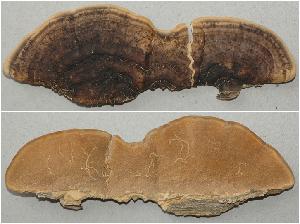
This genome was sequenced as part of the JGI Community Sequencing Program “Survey of the lignocellulolytic capabilities over the order Polyporales”. Within Agaricomycotina, the order Polyporales is the major group of wood decayers in temperate and tropical forests. As such, Polyporales have a pivotal role in the global carbon cycle. Lignocellulosic biomass is the most important carbon storage on the emerged land, and provides a renewable resource for the production of biofuels and chemicals, including value added chemicals. Polyporales are able to deconstruct the three main polymers of lignocellulose; cellulose, hemicellulose and lignin. In particular, white-rot fungi are able to totally degrade highly recalcitrant lignin polymers through the production of extracellular enzymes including laccases, lignin peroxidases, manganese peroxidases and versatile peroxidases. As a consequence, white-rot fungi have a high potential for biorefineries using raw lignocellulosic feedstock from different origins (dedicated crops, agricultural wastes, silviculture, etc.) that do not compete with food production or agricultural land.
Trametes is a cosmopolitan Fungal genus which members cause white rot of wood. Species of Trametes are of high biotechnological interest due to their ability to produce extracellular lignin-degrading enzymes. Trametes cingulata occurs in the paleotropics, Asia and is common throughout Africa, south of Sahara. It is found on deciduous wood, often on the decorticated trunks in open and sunny localities. The genome sequencing for Trametes cingulata will allow exploration for novel biocatalysts and deepen our understanding on the functional diversity among Polyporales, i.e. enzymatic capabilities linked to lignocellulose degradation.
Genome Reference(s)
Hage H, Miyauchi S, Virágh M, Drula E, Min B, Chaduli D, Navarro D, Favel A, Norest M, Lesage-Meessen L, Bálint B, Merényi Z, de Eugenio L, Morin E, Martínez AT, Baldrian P, Štursová M, Martínez MJ, Novotny C, Magnuson JK, Spatafora JW, Maurice S, Pangilinan J, Andreopoulos W, LaButti K, Hundley H, Na H, Kuo A, Barry K, Lipzen A, Henrissat B, Riley R, Ahrendt S, Nagy LG, Grigoriev IV, Martin F, Rosso MN
Gene family expansions and transcriptome signatures uncover fungal adaptations to wood decay.
Environ Microbiol. 2021 Oct;23(10):5716-5732. doi: 10.1111/1462-2920.15423
